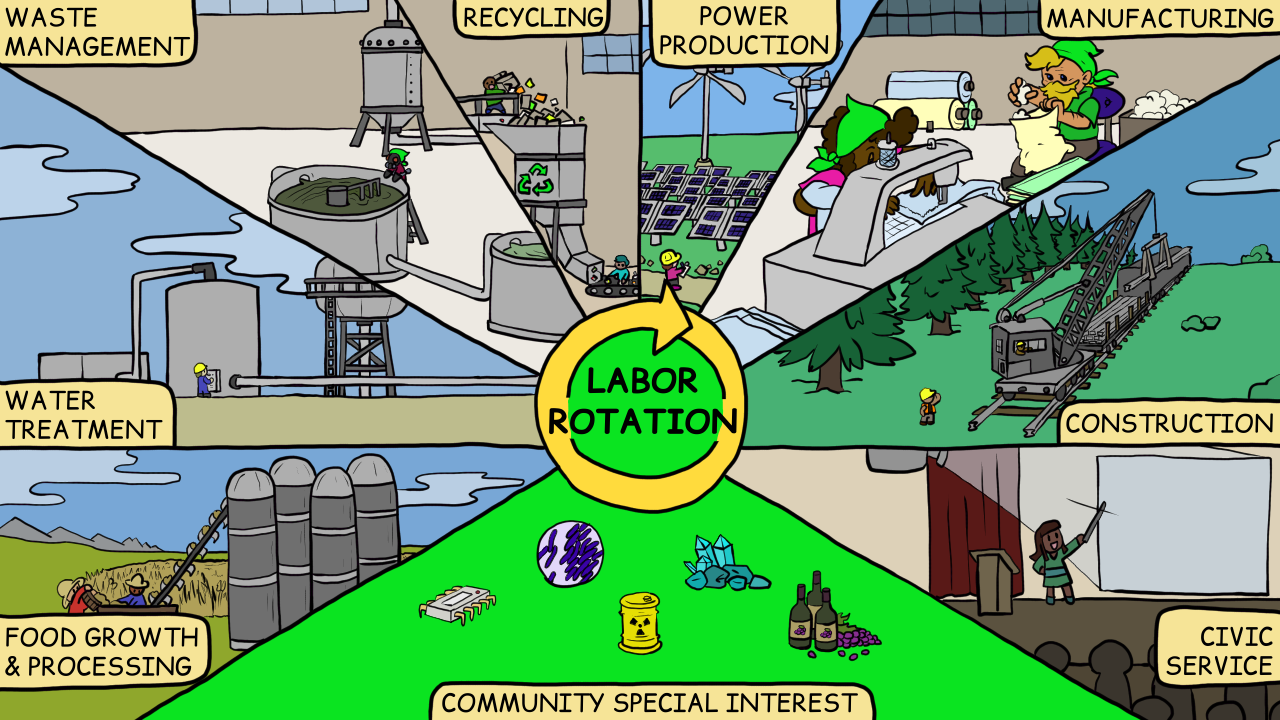Labor

Most students graduate high school at age 18 and join the labor force, entering into what is called a "labor learning rotation." This rotation is a two-year program that cycles new laborers through each of the essential labor positions in the community. This gives everyone in the community a relatively complete knowledge of how the community is run and maintained. Simultaneously, it provides the chance to explore different options for students who are unsure of what kind of career they want to pursue.
Although labor contributions are "required," this goes against the Forwardist belief that the individual has ultimate sovereignty. While most citizens of the Forwardist confederation find the request to support their community agreeable, anyone who disagrees cannot and will not be forced to work. The options for labor contracts are very flexible, and designed to accomodate any needs an individual might have. The purpose of "requiring" labor contracts is solely to build, maintain, and improve the community. If a citizen chooses not to sign a labor contract of any kind, they will still be given access to all of the basic resources needed to live, though any additional resources will typically be reserved for other citizens who are willing to contribute.
Table of Contents
Essential Labor Positions
^ Back to table of contents ^It isn't necessary for anyone to choose a career, and only those who feel compelled toward a certain profession tend to specialize beyond the basic essential labor positions. Many people choose to work in one location regularly because they feel more comfortable doing the same type of work. Another choice is to pick a "flexible position," which means that the work you do varies from day-to-day, depending on the needs of the community. The individual has the choice whether they want to have set or flexible hours as well. Nearly every individual in the community is asked to contribute 20 hours per week, with some notable exceptions. Anyone who has not graduated from school is exempt from labor requirements, as well as anyone who is disabled (temporarily or permanently). Citizens past the age of 60 are considered retired and are no longer required to contribute labor hours (though many still work with lessened hours). Parental leave is given to both parents whenever a new child enters the household. This leave period lasts 6 months for both parents, and when the end of the 6 month period is reached, one or both parents can apply for reduced hours or continued leave as needed.
Essential labor positions include all positions that are necessary for the basic functioning of the community. Examples of this include things like agriculture, food distribution and preparation, energy generation, waste processing, water treatment, and industrial jobs. Another position that is somewhat unique is the "neighborhood committee" position. This is not a position that can be chosen by any individual to fill. Instead, every six months there is a random drawing that elects new members to fill the committee. Committee members are responsible for sharing the voices and views of the neighborhood they represent whenever they are making choices about how the community should be run.
Specialized Labor Positions
^ Back to table of contents ^Some positions within forwardist communities are unavailable to citizens unless they have scored with certain proficiencies on the placement exam that every newly-graduated laborer takes. This exam is freely available every six months and can be taken as many times as someone wants to. These are positions such as social workers, medical professionals, researchers, artists, engineers, and any other position that requires a specific skill set. Once someone has displayed a sufficient skill level in the placement exam, they are permitted to choose a specialized position as their primary labor contribution to the community.
Recruitable Labor
^ Back to table of contents ^If someone has a project that they want to work on that's not directly related to the good of the community, this work does not count towards the agreed upon number of community labor hours for the individual. The labor requirements are designed to ask for the minimum necessary amount of work from every worker so that everyone can have as much leisure time as possible. In this time, one can do as many projects as they may want to do. If someone finds that they need help with something they want done, a request can be put up for a "recruitable labor" task. Anyone else in their community can see these posted requests and fill them if they see promise in the project, or even if they're bored and looking for something to do. Accepting these types of requests is entirely voluntary, with extortion or coersion outlawed.
There is no immediate benefit from accepting these types of labor requests (other than helping one's community members). This type of labor does not count towards one's community labor hour requirements. However, it can be used to show goodwill to the community in cases where an individual wants to request additional resources of some kind from their community. It can also be counted as valid experience if one is trying to apply for specialized positions.
^ Back to table of contents ^